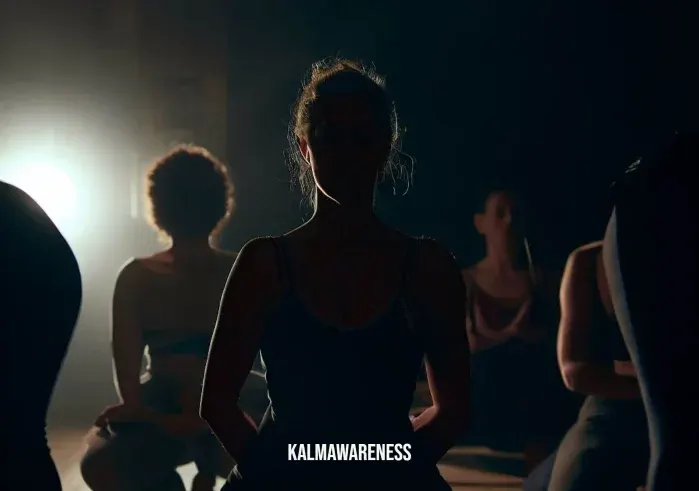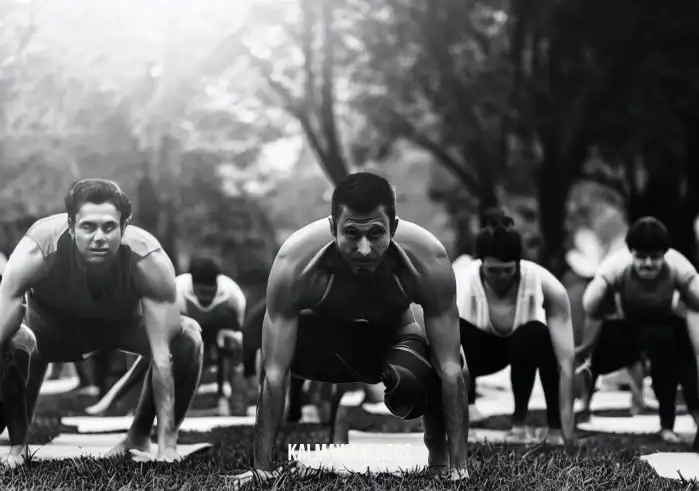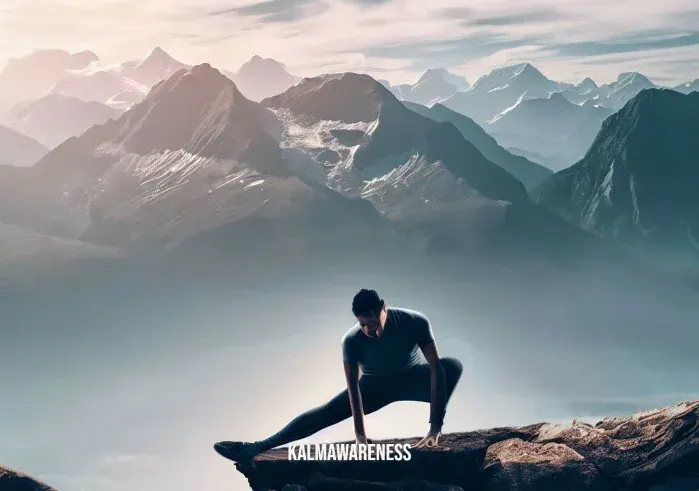Deep Squat Yoga Pose: Discover the Depths of Serenity
| Description | Explanation |
|---|---|
| Pose Name | Deep Squat Yoga Pose |
| Original Name | Malasana |
| Difficulty Level | Intermediate |
| Pose Category | Standing Poses |
| Exercise Duration | Beginners: 30 seconds – 1 minute; Advanced: 1 – 2 minutes |
Introduction: Embrace the Deep Squat Yoga Pose
Welcome to the enchanting world of yoga, where each pose unveils a unique journey to inner peace and physical vitality. Today, we invite you to explore the transformative Deep Squat Yoga Pose, also known as Malasana. This empowering pose, found within the Standing Poses category, will guide you into a state of profound serenity and connection with your body.
The Deep Squat Yoga Pose Unraveled
Are you ready to delve into the heart of this magnificent pose? The Deep Squat Yoga Pose, with its roots in traditional yoga practice, exudes grace and strength. Malasana, derived from the Sanskrit words “mala” (garland) and “asana” (pose), translates to “Garland Pose” – a name that evokes a sense of beauty and fluidity.
In Malasana, you find yourself in a deep squatting position, with your feet firmly grounded and your hips lowered towards the earth. This posture grants a profound stretch to your thighs, groins, and ankles, while simultaneously toning your core muscles. The deep squat embraces both strength and flexibility, making it an ideal choice for intermediate practitioners seeking to deepen their yoga journey.
The Journey to Stillness: Benefits of Deep Squat Yoga Pose
The Deep Squat Yoga Pose offers a myriad of physical and mental advantages that make it a cherished posture in the yoga community. Here are some remarkable benefits you can reap from integrating this pose into your practice:
- Strengthens Lower Body Muscles: As you lower into the deep squat, your quadriceps, hamstrings, and calves work harmoniously to maintain balance and stability, building strength and resilience in your lower body.
- Hip Flexibility: Regular practice of Malasana helps open and loosen tight hips, improving flexibility and mobility in this vital joint.
- Digestive Wellness: The deep squatting position stimulates your digestive organs, aiding in digestion and promoting a healthy digestive system.
- Emotional Release: Malasana is renowned for its ability to release tension in the hips, where we often carry emotional stress. By surrendering to this pose, you may experience emotional liberation and a sense of calm.
- Grounding and Focus: Connecting with the earth through your feet in the deep squat fosters a grounding sensation, enhancing your focus and presence during your practice.
- Pelvic Floor Activation: This pose engages the pelvic floor muscles, contributing to better pelvic health and promoting awareness of this essential area.
Stepping into Stillness: Practicing the Deep Squat Yoga Pose
The journey to mastering the Deep Squat Yoga Pose begins with a mindful approach and patience. Whether you are a seasoned yogi or a curious beginner, we encourage you to explore this posture with an open heart and a tranquil mind.
Step-by-Step Guide to Deep Squat Yoga Pose:
- Starting Position: Stand with your feet slightly wider than hip-width apart, toes pointing slightly outward.
- Descending into the Squat: Exhale and slowly bend your knees, lowering your hips towards the ground. Aim to bring your thighs parallel to the floor. If needed, use a block or folded blanket under your heels for support.
- Hands in Prayer: Bring your palms together at your heart center in a prayer position (Anjali Mudra).
- Press Elbows on Inner Thighs: Gently press your elbows against your inner thighs, encouraging them to move outward. This action helps to open your hips further.
- Lengthen Your Spine: Elongate your spine, keeping your back straight and your chest lifted. Engage your core to support the lengthening of your spine.
- Relax Your Shoulders: Soften your shoulders away from your ears, allowing your upper body to relax.
- Gaze Forward: Direct your gaze forward, maintaining a steady focus.
- Breath Awareness: Breathe deeply and evenly in this pose, maintaining a sense of calm and relaxation.
- Exiting the Pose: To release the pose, exhale and place your palms on the floor. Gradually straighten your legs and return to a standing position.

Deep Squat Yoga Pose: Embrace the Transformative Benefits
In the enchanting realm of yoga, each pose holds within it a treasure trove of benefits waiting to be discovered. As we delve deeper into the captivating world of the Deep Squat Yoga Pose, also known as Malasana, let us unveil the transformative advantages that this empowering posture offers. Additionally, we will explore who may find it challenging to practice this pose and variations suitable for practitioners of different experience levels.
The Nourishing Rewards of Deep Squat Yoga Pose
In the seamless flow of your yoga practice, the Deep Squat Yoga Pose presents an array of nourishing rewards that encompass both the physical and mental aspects of well-being. By incorporating this pose into your regular routine, you invite a myriad of benefits into your life:
- Hip Flexibility and Groin Opening: As you lower into the deep squat, your hips open up, and your groins receive a gentle stretch. This release of tension improves flexibility in these crucial areas, promoting comfort and ease of movement.
- Toning and Strengthening: Malasana engages your thighs, hamstrings, and calves, strengthening these muscles and promoting stability in the lower body.
- Digestive Aid: The Deep Squat Yoga Pose stimulates the digestive organs, offering relief from digestive issues and enhancing the overall digestive process.
- Lower Back Relief: By elongating the spine and stretching the lower back, this pose provides relief for those experiencing mild lower back discomfort.
- Mental Clarity and Calmness: As you hold the pose, you cultivate a deep sense of presence and inner focus, calming the mind and reducing stress.
- Pelvic Floor Health: Practicing Malasana activates the pelvic floor muscles, promoting better pelvic health and overall well-being.
- Preparation for Childbirth: Deep squatting is often recommended for expectant mothers as it strengthens the pelvic floor and opens up the hips, providing potential benefits during childbirth.
- Natural Detoxification: The gentle compression on the abdominal region in Malasana encourages the flushing of toxins and waste materials from the body.
The Cautionary Notes: Who Should Avoid Deep Squat Yoga Pose?
While the Deep Squat Yoga Pose holds numerous benefits, certain individuals may need to approach this pose with caution or refrain from practicing it altogether. It is essential to listen to your body and consult with a qualified yoga instructor or healthcare professional if you have any concerns. The following are individuals who might need to avoid or modify the Deep Squat Pose:
- Knee Issues: If you have knee injuries or chronic knee pain, Malasana may exacerbate the discomfort. Consider using props or modifying the pose to reduce the strain on your knees.
- Lower Back Problems: Individuals with severe lower back issues, such as herniated discs or sciatica, should approach this pose carefully or avoid it to prevent further strain.
- Ankle Instability: People with weak or unstable ankles should exercise caution while practicing this pose. Supporting the heels with a block can provide additional stability.
- Pregnancy: Pregnant individuals may find it challenging to maintain balance and stability in the deep squat. Consult with a prenatal yoga instructor for suitable modifications.
- Hip or Groin Injuries: Those with acute hip or groin injuries should avoid this pose, as it might worsen the condition. Gentle hip-opening poses might be more appropriate during the healing process.
Exploring Variations: Adapting the Pose for Different Levels
The beauty of yoga lies in its adaptability to various practitioners’ needs and abilities. To accommodate practitioners of different experience levels, let us explore variations of the Deep Squat Yoga Pose:
- Supported Deep Squat: For beginners or individuals with limited hip flexibility, placing a block under the sit bones can ease the stretch and provide additional support.
- Bound Angle Pose (Baddha Konasana) Variation: For a gentler hip opener, bring the soles of the feet together in a seated position, allowing the knees to drop to the sides. This modification reduces the intensity of the squat.
- Lifted Heels: If you have ankle mobility issues or find it challenging to keep the heels grounded, place a rolled-up mat or a folded blanket under the heels for support.
- Advanced Variation – Crow Pose Transition: For experienced practitioners seeking an extra challenge, work on transitioning from Malasana into Crow Pose (Bakasana) by shifting the weight forward and lifting the feet off the ground.
Continue Your Journey: Deepening Your Practice
The transformative benefits of the Deep Squat Yoga Pose unfold as you embrace this posture with patience, dedication, and mindfulness. Remember that yoga is a personal journey, and modifications are encouraged to suit individual needs.
In the next part of this enlightening series, we will unveil a harmonious cluster of poses that beautifully complement the Deep Squat Yoga Pose, guiding you towards a profound understanding of the interconnectedness of yoga. Prepare to immerse yourself in the art of movement, stillness, and self-discovery.

Deep Squat Yoga Pose: Unveiling the Mystique of Time and Spirit
As we embark on the final part of our journey through the captivating world of the Deep Squat Yoga Pose, it is time to uncover the rich history and spiritual significance that surround this ancient posture. Additionally, we will delve into invaluable tips to deepen your practice, common mistakes to avoid, and variations tailored for those with injuries or limited flexibility. Moreover, we will explore a harmonious cluster of poses that beautifully complement the Deep Squat, enhancing your overall yoga experience.
The Roots of Deep Squat Yoga Pose: A Glimpse into Its History
The Deep Squat Yoga Pose, known as Malasana in Sanskrit, carries a lineage of wisdom passed down through generations of yogis. Rooted in the ancient traditions of yoga, this powerful posture has been revered for centuries for its transformative qualities.
The name “Malasana” finds its origin in the Sanskrit words “mala” (garland) and “asana” (pose). The term “mala” symbolizes the interconnectedness of all living beings, while “asana” signifies a pose or posture. In essence, Malasana embodies the idea of unity and the harmonious flow of energy within the body and the universe.
Embracing the Spiritual Essence: The Deeper Meaning of Malasana
Beyond the physical benefits, the Deep Squat Yoga Pose holds profound spiritual significance. As you settle into the deep squat, you are encouraged to let go of tension and surrender to the present moment. The following spiritual aspects are intertwined with the practice of Malasana:
- Grounding and Connection: Malasana roots you firmly to the earth, reminding you of your connection to the planet and the universe as a whole. It fosters a sense of stability and groundedness.
- Svadhyaya (Self-Study): The deep squat encourages introspection and self-reflection, offering an opportunity for self-study and personal growth.
- Mula Bandha Activation: In this pose, the activation of Mula Bandha, or the root lock, promotes a sense of centering and inner strength.
- Anahata Chakra Activation: The heart chakra, known as Anahata, is stimulated in Malasana, fostering a feeling of love, compassion, and interconnectedness.
Tips for an Enriching Practice: Deepening Your Experience
As you continue to explore the depths of the Deep Squat Yoga Pose, consider these valuable tips to enhance your practice and experience the full potential of this posture:
- Breath Awareness: Maintain steady and conscious breathing throughout the pose. Deep inhales and exhales help you stay connected to the present moment.
- Spinal Alignment: Focus on elongating your spine while in the deep squat to prevent rounding in the upper back.
- Hip Engagement: Engage your hip muscles to create stability and openness in the hips. Press your elbows gently against the inner thighs to encourage hip opening.
- Pelvic Floor Connection: Activate the pelvic floor muscles to support the lower back and provide a strong foundation for the pose.
- Modifications for Comfort: Use props such as a block, cushion, or blanket under your heels or sit bones for added support and comfort.
- Gaze and Focus: Maintain a soft gaze ahead, allowing your focus to remain on the breath and the sensations in your body.
Avoiding Pitfalls: Common Mistakes in Deep Squat Yoga Pose
As with any yoga posture, it’s essential to approach Malasana mindfully and avoid potential pitfalls. Here are common mistakes to steer clear of during your practice:
- Rounded Spine: Avoid rounding the spine and collapsing into the pose. Focus on maintaining a long and straight spine.
- Overexertion: Do not force yourself into a deep squat if it feels uncomfortable or painful. Honor your body’s limitations and work within your range of motion.
- Knee Alignment: Be mindful of your knee alignment. Ensure that your knees track over your toes and do not collapse inward.
- Shoulder Tension: Avoid tensing your shoulders; instead, relax them away from your ears for a more comfortable experience.
Adapting the Pose: Modifications for Individual Needs
Yoga is an inclusive practice that accommodates various body types and abilities. Here are modifications for those with injuries or limited flexibility:
- Chair Malasana: For individuals with knee or ankle issues, practice Malasana using a chair for support. Place your feet hip-width apart and slowly lower your hips towards the chair’s edge.
- Wall Support: Stand facing a wall and use it for support while descending into the squat. This modification provides added stability for those with balance concerns.
- Props for Comfort: Utilize props such as blocks or bolsters under your sit bones to elevate your hips slightly, reducing strain on the knees.
Embracing Harmony: Poses Complementary to Deep Squat
To round out your yoga practice, consider incorporating these poses that beautifully complement the Deep Squat Yoga Pose:
- Crow Pose (Bakasana): This arm balance pose strengthens the core and arms, making it a wonderful transition from Malasana for advanced practitioners.
- Garland Pose Twist (Parivrtta Malasana): Deepen the hip opening and spine twist by adding a twist to Malasana, promoting spinal flexibility and detoxification.
- Seated Forward Fold (Paschimottanasana): Follow up your deep squat with a forward fold to stretch the hamstrings and decompress the spine.
The Beauty of Continuation: Your Yoga Journey Unfolds
As we conclude this integral article on the Deep Squat Yoga Pose, we hope you have found inspiration, knowledge, and new dimensions to your practice. The journey of yoga is a lifelong path of self-discovery and growth, embracing the interconnectedness of body, mind, and spirit.
We encourage you to carry the wisdom of Malasana into your daily life, embracing the grounding essence it offers and the profound connection it fosters within. Continue to explore the vast and diverse world of yoga, for it holds endless possibilities for transformation and spiritual awakening.
Thank you for joining us on this enlightening voyage. Until we meet again on the mat.




